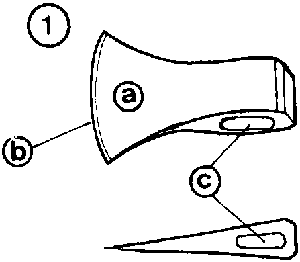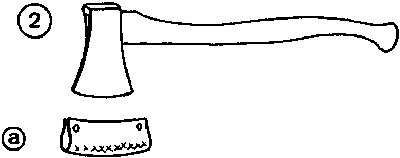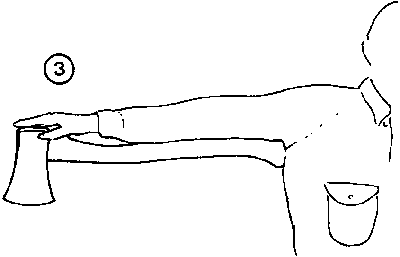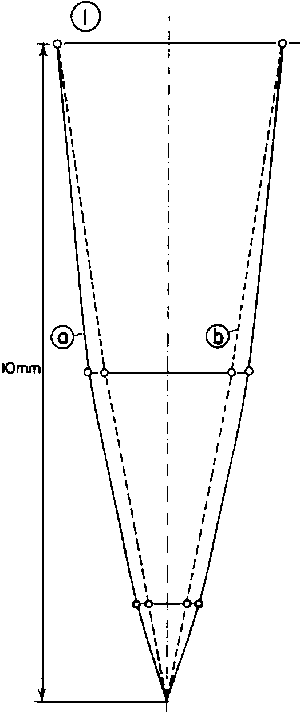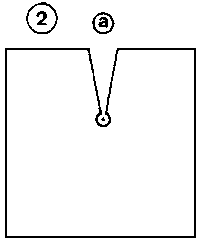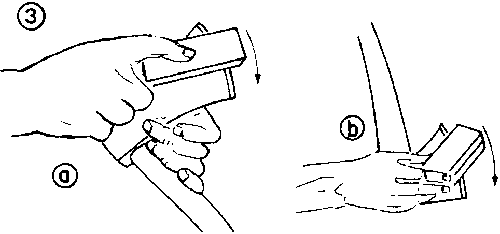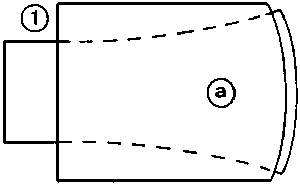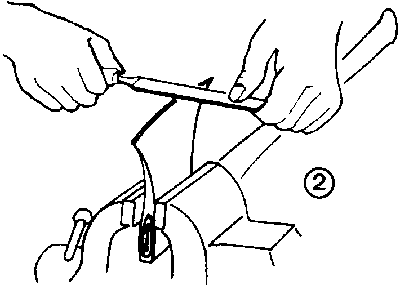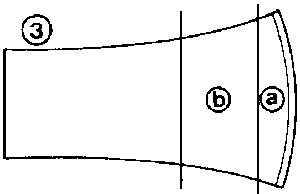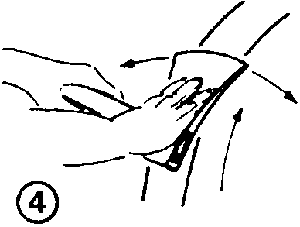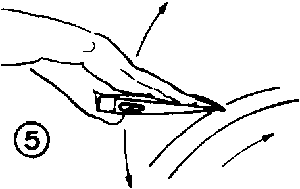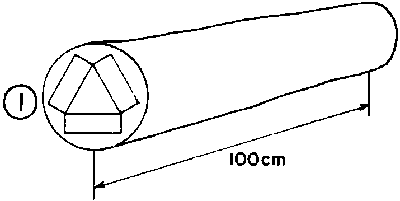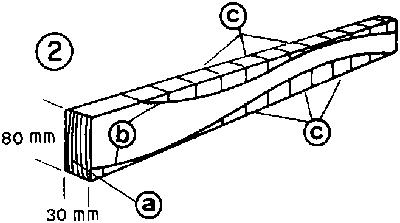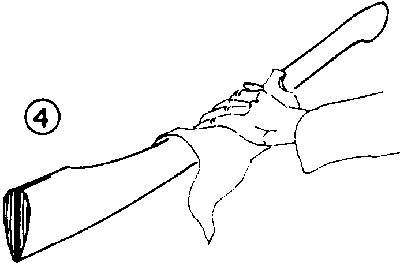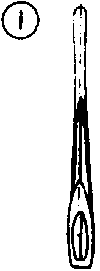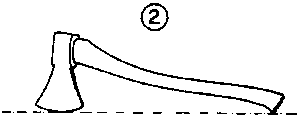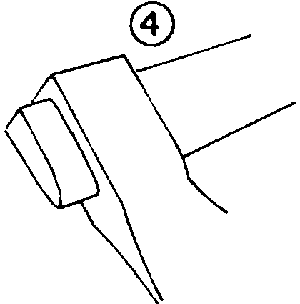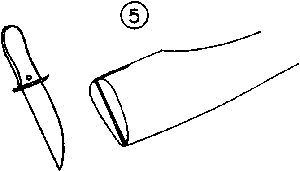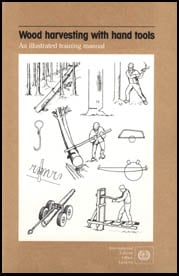
Axes[edit | edit source]
USE AND TYPES OF AXES[edit | edit source]
In traditional wood harvesting, the axe is used as a universal tool for felling, debranching, cross-cutting, splitting and debarking.
The main advantages of axe work are the simple tool outfit and easy maintenance.
However, it is heavy work and may waste a lot of wood and cause many accidents, including very serious ones.
Axe work should be restricted to the felling of very small trees, to preparation for the felling of larger ones and to debranching,
Axes made by local blacksmiths may be quite good for traditional use if they are properly hardened and well shafted.
The axe consists of a steel head fitted to a wooden handle. The most important part of the head (1) is the blade (1a), ending in the edge (1b). The wooden handle is fitted into the eye (1c). Modern axes are shaped like a wedge and have an oval eye which prevents the handle from turning in the eye.
Special types of axes can be used for felling and debranching. However, in most cases a universal axe is used for both jobs.
For professional work, the type of axe shown in the picture is recommended (2). The weight should be from 0.8 to 1.5 kg, the length of the handle from 60-80 cm, depending on the length of the worker's arms (3). The handle should have fawnfoot shape (2) and be made of strong wood. Workers should be able to make handles and to replace broken handles themselves. During transport, the axe blade should be secured with a protective cover which can be made easily, e.g. from a worn bicycle tyre (2a).
To keep the axe sharp, repeated maintenance is needed during the course of the day using a whetstone (see page 8).
Figure
Figure
Figure
MAINTAINING AN AXE[edit | edit source]
Taper
The axe blade has a curved taper towards the edge. During sharpening it is important that the correct taper is maintained.
Heavy axes and axes used to cut hard wood and frozen wood require a stronger blade close to the cutting edge (1a).
Lighter axes and axes used for soft wood should be thinner close to the cutting edge (1b).
Although wood of coniferous trees is usually soft, branches may be very hard and axes may require the same taper as for hard wood.
Taper gauge
The taper of new axes is usually suitable for average conditions. A gauge can be made from a piece of metal sheet corresponding to the taper of the new axe (2a). This gauge can be used during maintenance. If the axe "bites", the taper is too small and if the axe does not penetrate enough into the wood, the taper is too big. Adjustments are made during maintenance and when the taper corresponds to the requirements, the taper gauge can be adjusted accordingly.
Daily maintenance
Hone the axe several times daily with a whetstone (3). Use water or spit on the whetstone to keep it moist. Honing is done downwards on one side with the handle down (3a) and on the other side with the handle up (3b).
Figure
Figure
Figure
Major overhaul
This is done at intervals of about a week or longer depending on the use of the axe. Major overhaul is done by the following steps:
- Check curve of edge with a new axe or a curve gauge (1). A curve gauge can be made locally from a metal sheet (1a), using a new axe to copy the correct curve.
- If necessary, correct curve with millsaw file (page 6), holding the axe in a vice (2).
- Grind axe blade on grindstone in zone 3a, by moving the axe from right to left (4) and at the same time up and down (5). Grind zone 3b only at longer intervals, if necessary, by moving the axe from left to right (4).
- Final honing is done as for daily maintenance with a whetstone to remove burrs and to polish the surface of the axe (see 3, previous page).
If a grindstone is not available, a millsaw file can be used for sharpening. Care must be taken to file a correct taper. Always move file away from the cutting edge.
Figure
Figure
Figure
Figure
Figure
MAKING AN AXE HANDLE[edit | edit source]
To make an axe handle, hardwood of high elasticity and strength is taken from the butt end of a young tree or from the outer zones of an old one. The wood must be well seasoned. It should have straight fibres and be free of knots and bends.
A scantling is sawn or squared with an axe out of a suitable piece of wood (1). Annual rings should run through the scantling as indicated in the drawing (2a). The scantling must be well seasoned before the handle is made.
A model of a fawnfoot handle is used for drawing the outline of the handle on the scantling (2b). The model can be copied from a new handle on a piece of cardboard.
A bow saw is used for making cuts into the wood to be taken off from the scantling (2c).
An axe can be used for shaping the outline of the handle.
Final shaping is done with a spokeshave (3), if available, and a wood rasp (see page 6).
The handle is finished by polishing with sandpaper (4), a piece of glass (for instance, window glass), or a knife.
Making an axe handle is easier if a vice can be used (see page 12)
Figure
Figure
Figure
Figure
SHAFTING AN AXE[edit | edit source]
When shafting an axe, care must be taken to ensure:
- that the blade and the handle are in exactly the same plane (1);
- that the centre of the blade touches the surface if the axe is placed with the blade and the end of the handle on a level surface (2).
Shafting is done by the following steps:
- Fit the handle exactly to the eye of the axe, preferably with a wood rasp (3).
- Put handle into the eye (4) and test for correct alignment (1, 2).
- Take the handle out and cut with a knife or axe to the depth of the eye (5).
- Put the handle into the eye again and drive a small hardwood wedge into the saw cut (6).
- Test for correct alignment (1, 2). If necessary, adjust alignment with the wood rasp after having taken off the head of the axe once more.
- If the alignment is correct, put 2 small nails across the handle, and wedge it above the head of the axe (6a), saw off the protruding part of the handle and wedge about 1 cm above nails.
Note: If an axe is reshafted, drive the remaining wood out of the eye either from the unwedged side or from the wedged side once nails and wedge have been removed. Never burn wood still remaining in the eye: by doing this, the axe's temper would be lost and it would become useless.
Figure
Figure
Figure
Figure
Figure
Figure
